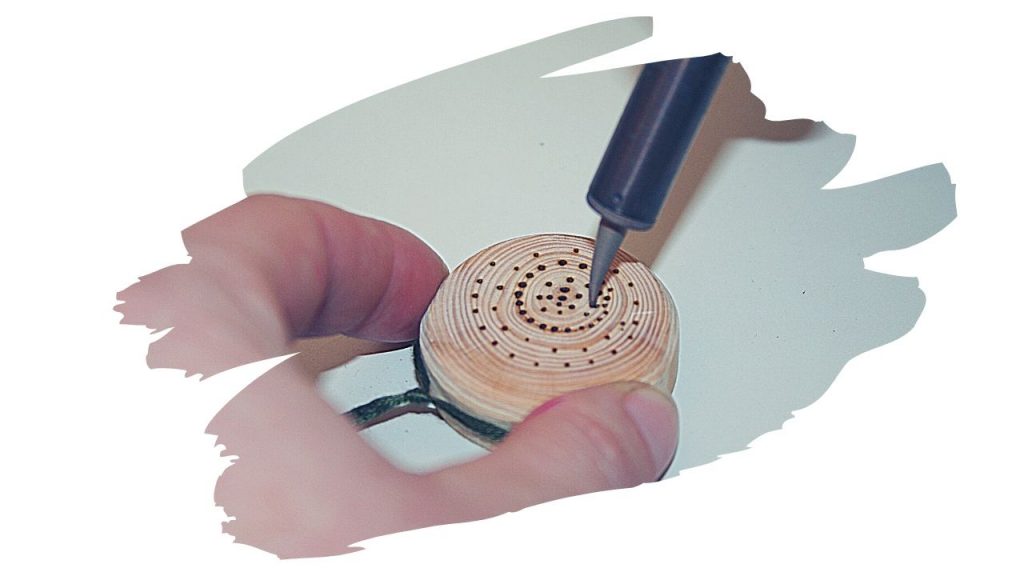Sealing wood, (especially wood that has just had a Pyrography design burned into it), is the best way to give your work a natural and durable finish.
But can you wood burn over polyurethane?
In short, it is not recommended. Why? Well, typically we apply a finish or sealant after burning – not before. Also, the fumes released from all that burnt poly-coated wood smells awful. A better option would be to strip the finish off first, before doing any burn work on the wood.
You can use a chemical stripping solution, or a varnish removal solvent, to take off that poly coat.
For a chemical-free alternative, you can simply sand off the top layer of sealant using sandpaper or an orbital sander. It’s really up to you.
However, there are a few more little details you need to consider when it comes to polyurethane, wood sealing, and the artful craft of wood burning (otherwise known as Pyrography).
Let’s take a look at some of them:

This post may contain affiliate links to products that we receive a commission for (at no additional cost to you). Learn more here.
Can you seal burnt wood?
First of all, lets start of with the basics. Can you seal burnt wood in the first place?
The simple answer is yes you can. Burnt wood is more resistant to wear and tear than untreated timber. However, it will still need some extra shielding to protect it from chipping, and moisture.
So, in most cases, your fine wood torched project will need some kind of water-resistant oil coat, such as Danish Oil, or Linseed oil.
Danish Oil is one of the most popular wood finishing oils on the market, but it has its Pro’s and Con’s. And we covered them all here on The Woodwork Place. Click here to learn more about it in our article ‘Danish Oil: Advantages and Disadvantages’.
So, what do you use to seal burnt wood?
You have a few different options when it comes to sealing burnt wood.
Typical wood finish oils like a water-based Poly, Tung Oil or Teak Oil are often used. These types of oil finishes really soak into the wood – giving the wood some deep penetrating protection without leaving an oily looking sheen.
However, some wood burning enthusiasts have even been known to use everyday items such as hairspray, and even Krylon Clear Matte spray (a finish typically used on Paintings) to help seal and protect their designs.
So, what is the best sealant for wood burning?
The best sealant would be all of the above, and which one you ultimately choose is up to you.
However, if you were to simply use a quick drying linseed or tung oil, you won’t go too far wrong in giving that burnt wood a long-lasting coat.
Is it safe to burn wood with polyurethane?
The smoke from burning polyurethane can do a lot more to you than simply have you turning up your nose at the smell.
Despite being non-toxic after it dries, the gas released from burning polyurethane isn’t something you want to be breathing in.
You see, polyurethane contains compounds called isocyanate’s. And exposure to isocyanate’s (particularly through inhalation) can cause chest tightness, damage your lungs, and just make it all around difficult for you to breathe.
Now, whilst a water-based poly is less toxic than its oil-based cousin, it still contains harmful compounds in the fumes it releases.
If you absolutely have to burn wood that has been coated in a poly finish, it is important that you do this outside (or in a very well ventilated room) whilst wearing a quality respirator that protects your lungs from gases and fumes.
One of the best respirators on the market is the 3M Quick Latch Half Face-piece Reusable Respirator 6501QL.
Check out the latest prices for this respirator mask on Amazon.com
Can you stain over a wood burning craft?
Okay, so you’re getting ready to seal your wood burning project, but at the last minute, you decide that you want to also give it a bit more color and tone.
Well, staining over the wood is a real option here, and you’re in luck. You can stain over a wood burning project with any wood stain shade you choose.
It’ll do the same job as the sealant, (give the wood some protection), whilst also giving it a rich earthy-looking hue to boot!
Some Final Thoughts
At the end of the day, the answer to ‘can you wood burn over polyurethane’ is pretty simple… no, you probably shouldn’t. And here’s why:
- You are better off sanding off the poly coat before you start wood burning.
- Burning polyurethane fumes smell really bad (and that scent can potentially linger on the wood afterwards).
- Also, burning polyurethane chemical fumes are potentially harmful to your health (when inhaled).
Stay safe!



